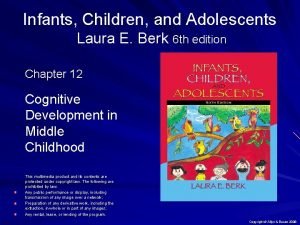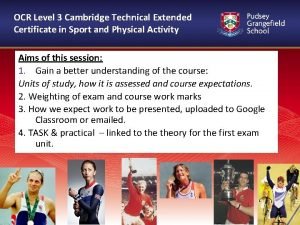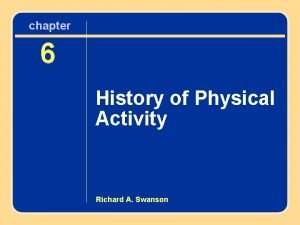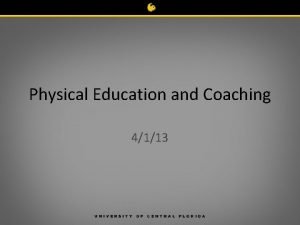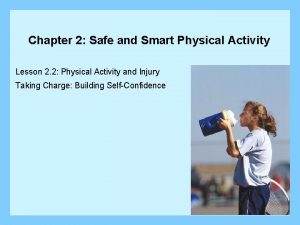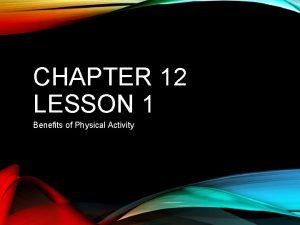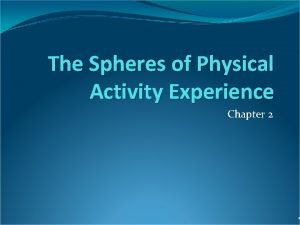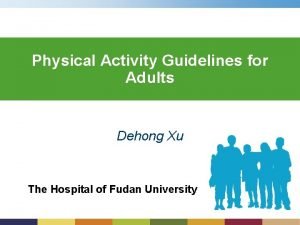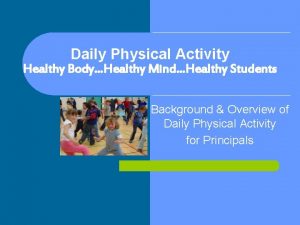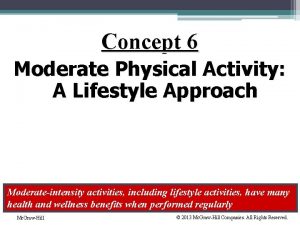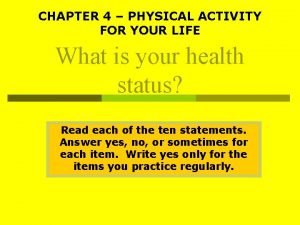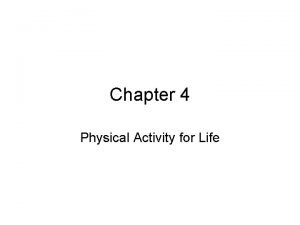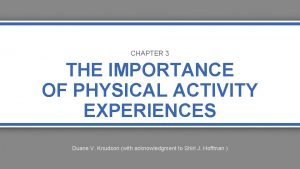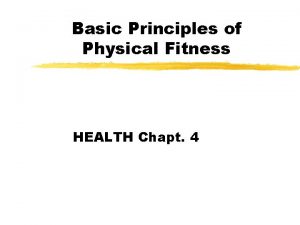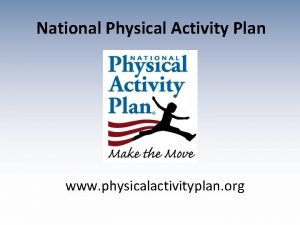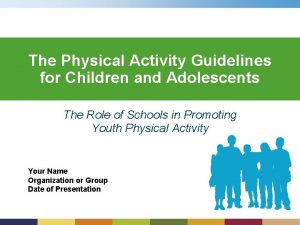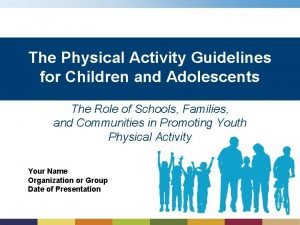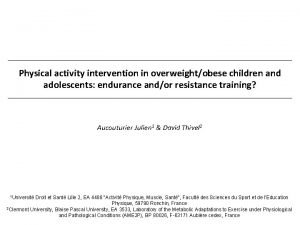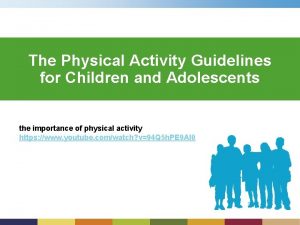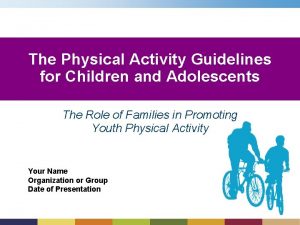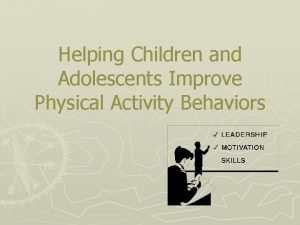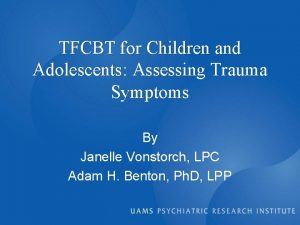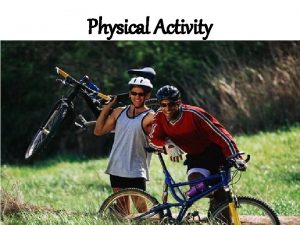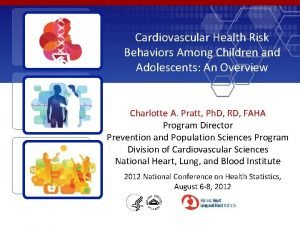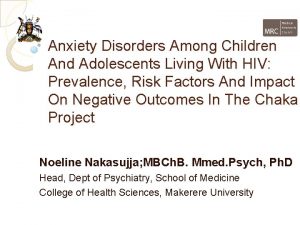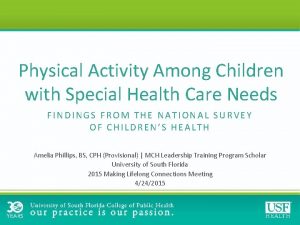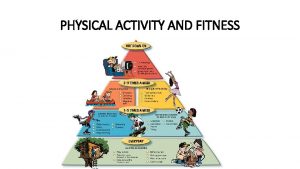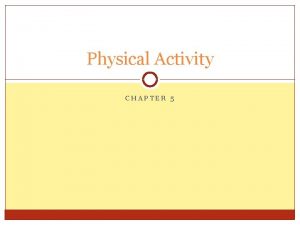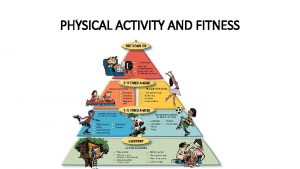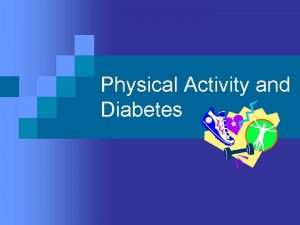Physical Activity Among Children and Adolescents Data from

































- Slides: 33

Physical Activity Among Children and Adolescents: Data from National Health and Nutrition Examination Survey (NHANES) 2003 -2006 Richard Troiano, Ph. D

Overview • NHANES 2003 -2006 accelerometer protocol • Accelerometer data use highlights – Prevalence studies – Trends – Epidemiological analyses • Coming attractions

NHANES 2003 -2006 ACCELEROMETER PROTOCOL

NHANES 2003 -6 PAM Protocol • Sample – Age 6+ • Sensor: Acti. Graph 7164 – Accelerometer: uniaxial (vertical) – 1 min epochs • Location – Worn over hip on elastic velcro belt • Wearing Protocol – 7 days, while awake – Remove for bathing, swimming, etc.

A Popular Data Resource – 54 publications as of December 31, 2011 – 15 focus on or include data for youth

PREVALENCE APPLICATIONS

First Objective PA Data Med Sci Sports Exerc, 2008 – – NHANES 2003 -2004 Age-specific thresholds for intensity Accumulated minutes above thresholds At least 4 days of 10+ hours

Activity is Much Lower for Teens Minutes (SEM) of Moderate or Greater Intensity Age Group 6 -11 12 -15 16 -19 Boys 95. 4 (4. 7) 45. 3 (3. 4) 32. 7 (2. 2) Girls 75. 2 (2. 0) 24. 6 (1. 8) 19. 6 (2. 4)

Girls Are Particularly at Risk Prevalence (% and SE) Meeting Recommendations* Age Group 6 -11 12 -15 16 -19 Boys 48. 9 (2. 8) 11. 9 (1. 7) 10. 0 (1. 6) * 60+ min/d on 5 out of 7 days Girls 34. 7 (1. 2) 3. 4 (0. 6) 5. 4 (1. 4)

Demographics Plus Weight Status Med Sci Sports Exerc, 2010 – – – NHANES 2003 -2006 Ages 6 -19 years Included those with 4+ days of 10+ hours Mean counts per minute Daily minutes sedentary, moderate, vigorous, and moderate-vigorous PA

Age-BMI Race-Ethnic Interactions Complex patterns of interactions Belcher, et al. , 2010

Age-BMI Race-Ethnic Interactions Belcher, et al. , 2010

Step Data Med Sci Sports Exerc, 2010 – – – NHANES 2005 -2006 Ages 6 -19 years At least 1 day of 10+ hours Age- and sex-specific thresholds for step categories Accumulated steps/day, uncensored and censored • Censoring steps with low counts approximates pedometer step counts – Steps/day highest at age 6 and then declines

Few Boys Meet Active Step Criteria Tudor-Locke, et al. , 2010

Girls Appear to do Slightly Better Tudor-Locke, et al. , 2010

CHANGES OVER TIME

Trends and Demographic Effects Med Sci Sports Exerc, 2012 – Ages 6 -19 years – Examined changes from 2003 -4 to 2005 -6 • Mean counts/minute and minutes of moderate-vigorous PA • Multiple regression – Included those with 4+ days of 10+ hours

Changes Between Cycles • Counts/minute: – Increased for children, but not adolescents – Increased for non-Hispanic white children – Decreased for non-Hispanic black and Mexican. American children • Minutes of moderate-vigorous PA – No detectable changes

ASSOCIATIONS

Do Activity Bouts Matter? Published: October 5, 2011 – NHANES 2003 -2006 – Ages 6 -19 y – Cardiometabolic risk score: • • Waist circumference Non-HDL cholesterol C-reactive protein Systolic blood pressure

Sporadic vs. Bouts of MVPA 5 -min bouts 10 -min bouts

Sedentary Behavior – – – NHANES 2003 -2006 Ages 6 -19 years Include 4+ days of 10+ hours, with one weekend day Volume and pattern (bouts, breaks) of sedentary time TV watching (questionnaire) Moderate+ intensity PA

High CRS Predictors • Low minutes of MVPA – Not sedentary volume or pattern • Reported TV time, but not computer time – May be mediated by obesity • TV and MVPA poorly correlated, so may need independent interventions

OTHER STUDIES

Relation of Activity to: • • • Weight status Adiposity Blood pressure Dyslipidemia Metabolic risk score • SES and acculturation among Mexican-American adolescents • Compare accelerometer and self-report

COMING SOON. . .

NHANES: Advancing with Technology 2003 -2006 Protocol • Splash proof – Off to swim or shower • Waist worn monitor • Waking hours only • Single axis of sensitivity • 1 summary value / minute • 72, 000 data point for 7000 participants in 2003 -4 2011 -2014 Protocol • Waterproof device • Wrist worn monitor • 24 hour instrument wear – Allows measures of sleep duration and efficiency • Triaxial data (X, Y, & Z planes) • 80 Hz raw data capture – 240 points/sec • 72, 000 data points per participant

NHANES 2011 -14 PAM Protocol • Sample – Age 6+ (3+ from 2012) • Sensor: Acti. Graph GT 3 X+ – Accelerometer: raw triaxial 80 Hz data – Ambient light sensor • Location – Worn on nondominant wrist • Attachment – Removable velcro band • Wearing Protocol – 7+ days of continuous wear (24/7)

Protocol Strengths and Benefits • Maximize protocol compliance by reducing • Missing days of wear • Missing hours during waking periods • Ability to detect upper body activities in addition to ambulatory patterns – Possibility of novel outcomes with pattern recognition

National Youth Fitness Survey • Ages 3 -15, target 1500 youth examined • Same locations as NHANES 2012 – Separate exam trailer • Some overlap plus unique measures with NHANES – Screener, sample person, and family Qx. – Dietary recall – Height, weight, BMI

NYFS Exam Components Component Accelerometer Treadmill Lower body strength Ages 3 -15 y 6 -15 y Grip strength Modified pull-up Plank Gross motor skills * 6 -15 y 5 -15 y 3 -5 y * Locomotor: run, gallop, hop, leap, horizontal jump, slide Object Control: striking a stationary ball, stationary dribble, kick, catch, overhand throw, and underhand roll.

Thank You!

Review Citation Tudor-Locke C, Camhi SM, Troiano RP. A Catalog of Rules, Variables, and Definitions Applied to Accelerometer Data in the National Health and Nutrition Examination Survey, 2003– 2006. Prev Chronic Dis 2012; 9: 110332.
 Infant child and adolescent berk 8th edition chapter 1
Infant child and adolescent berk 8th edition chapter 1 Infants, children, and adolescents 8th edition
Infants, children, and adolescents 8th edition Physical activity and physical fitness assessments grade 9
Physical activity and physical fitness assessments grade 9 Difference between courting and dating
Difference between courting and dating Debye huckel limiting law
Debye huckel limiting law Who global strategy on diet, physical activity and health
Who global strategy on diet, physical activity and health Ocr level 3 sport and physical activity
Ocr level 3 sport and physical activity History of physical activity teaches us about
History of physical activity teaches us about Chapter 12 lesson 1 benefits of physical activity
Chapter 12 lesson 1 benefits of physical activity Sports pedagogy definition
Sports pedagogy definition Physical activity and nutrition coordinator
Physical activity and nutrition coordinator Safe and smart physical activity
Safe and smart physical activity Safe and smart physical activity
Safe and smart physical activity Chapter 12 • lesson 1 benefits of physical activity
Chapter 12 • lesson 1 benefits of physical activity Physical and chemical properties sorting activity
Physical and chemical properties sorting activity Disadvantages of commercialization of sports
Disadvantages of commercialization of sports Pricing tripod in service marketing
Pricing tripod in service marketing Reactants products and leftovers
Reactants products and leftovers Difference between aoa and aon
Difference between aoa and aon Activity 1 introductory activity
Activity 1 introductory activity Activity 2 finding the sequence
Activity 2 finding the sequence Activity 2 finding the sequence
Activity 2 finding the sequence Activity 1 activity 2
Activity 1 activity 2 Objective of physical education
Objective of physical education Dehong xu
Dehong xu Moderate physical activity examples
Moderate physical activity examples Fit formula for moderate physical activity
Fit formula for moderate physical activity Way of life that involves little physical activity
Way of life that involves little physical activity Chapter 4 physical activity for life answers
Chapter 4 physical activity for life answers Physical activity experience
Physical activity experience Physical activity pyramid worksheet
Physical activity pyramid worksheet Chief medical officers physical activity guidelines
Chief medical officers physical activity guidelines Ancient near east countries physical education
Ancient near east countries physical education National physical activity plan
National physical activity plan

